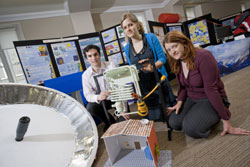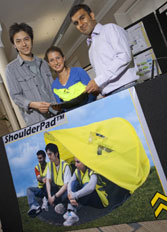Design Show 2009
|
The Design Show is held each year for an invited audience of local industrialists and designers. Students put together displays to explain the technical and business ideas behind the products, together with design details and prototype models of the products themselves. |
 |
|
|
|
||
Design projects |
||
The Pod |
||
|
A rocking chair with sensory limiting technology to calm autistic children The Pod has been developed with input from the Cambridge University Autism Research Centre (ARC) and a special autism school in London. Approximately one in 100 people in the UK experience autism. The Pod induces calm via a relaxing rocking motion and by limiting external sensory stimuli. The Pod is fully insulated and uses a careful dome-shaped design to limit peripheral vision and lower noise levels.
|
 |
|
ARK-Angel |
||
|
An avalanche rescue kit that dramatically increases an avalanche victim’s chance of survival
|
 |
|
EazyFeed |
||
|
A device for lowering and raising pet feeding bowls
The EazyFeed is an automated device for lowering and raising food and water bowls for cats and dogs. It is targeted at the many thousands of elderly and disabled people in the UK who find the task of feeding their pet a challenge. EazyFeed attaches onto a kitchen unit, and at the push of a button, transports a food and water tray from counter height to floor level, and back again. It prevents the user from having to bend down to provide food and water to their pet, yet allows them to retain some independence in caring for the pet. The tray can be easily detached to facilitate cleaning. EazyFeed has been designed for ease of manufacture, with considerable attention paid to the design detail, materials and number of components.
|
 |
|
SolarStore |
||
|
Solar-powered cold storage for hot places without mains electricity The SolarStore is a novel cold storage solution for off-grid locations. It differs from traditional refrigeration systems in that it uses the sun’s energy as a power source. Millions of households throughout the world lack grid electricity and would benefit from the ability to store perishable items without connecting to the grid. This product offers a sustainable and economical means of keeping food cold, preserving its life and reducing waste.
The SolarStore refrigerator is powered by a solar collector which concentrates the sun’s electromagnetic radiation to heat a pipe of water. The boiling water then drives an ammonia diffusion absorption refrigeration cycle, cooling the unit. With minimum running cost and low maintenance requirements due to a lack of moving parts, we expect the product to be a success, particularly in developing countries.
Team: Gareth Keeves, Anna Spinks, Lucy Browning |
 |
|
ShoulderPad ™ |
||
|
A safety system to encourage motorists who break down on motorways to leave their vehicle
Developed in consultation with the The Highway’s Agency, Survive and the Transport Research Laboratory ShoulderPad ™ is a hard shoulder safety system that aims to create a comfortable environment, away from the dangers of the motorway, giving the driver more incentive to leave their car. It includes equipment required to provide warmth, shelter, visibility and protection from the dangerous motorway environment. The key element is a pop-up shelter - a temporary base for the motorist, deployable in seconds.
|
 |
|
Sanditiser |
||
|
An economical solution to providing clean water in developing countries
|
 |
|
gym-arm |
||
|
An exercise prosthetic for amputees
Amputees rely on their local centres to ‘botch something together’ in order to meet any special needs or requirements. Current options include strapping sandbags on to their residual limb as a substitute for weights, or using a paddle-like attachment to go swimming. In both cases, since the loads applied are limited, they perform high repetition exercises that are generally associated with muscle definition instead of development.
|
 |
|









